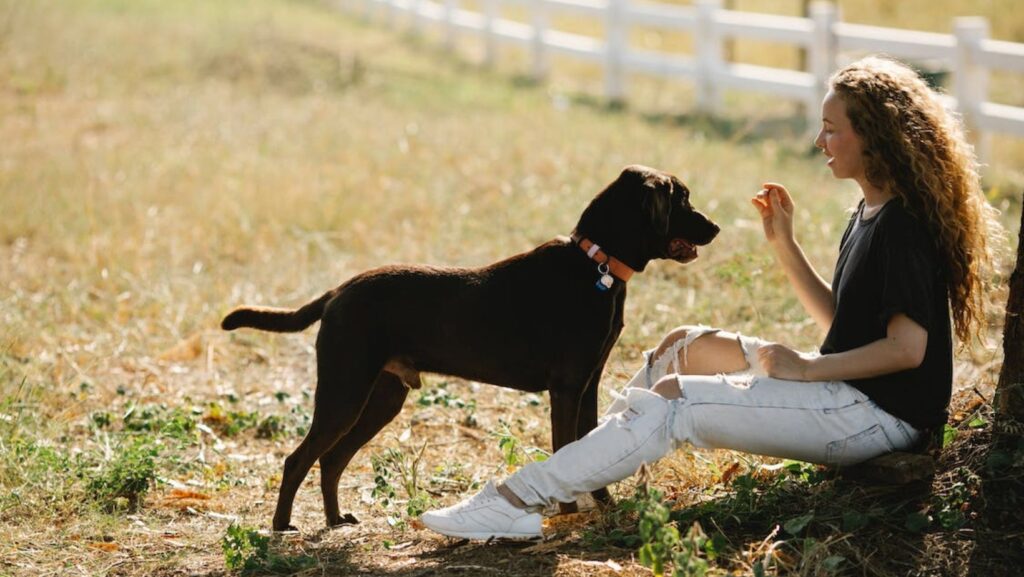If you’re a dog owner, you may have heard of martingale collars, but do you know how they work? People use martingale collars for control and to prevent dogs from slipping out. Common for dogs that pull or have smaller necks (e.g. greyhounds, whippets). In this article, we will explore how does martingale collar work, their benefits, training techniques, and common misconceptions.
How does a Martingale collar work?
Martingale collars have two loops – a larger one around the dog’s neck and a smaller one for the leash. We use a sliding material to create the smaller loop, allowing the collar to tighten when the dog pulls or tries to slip out. The collar tightens to a safe extent, preventing choking or injury to the dog.
The martingale collar tightens when the dog pulls, preventing escape. It provides a gentle correction for discouraging pulling behavior, making it an effective training tool for leash training.
Benefits of Using a Martingale Collar
To get know about how martingale collar work, will benefit dog owners seeking humane control during walks or training. Some of the key benefits include:
- Increased Control: Martingale collars provide effective control over the dog’s movements, preventing pulling or escaping.
- Injury Prevention: Unlike choke collars, martingale collars prevent choking or injury while still providing control.
- Comfortable Fit: Martingale collars are designed to fit comfortably around the dog’s neck, avoiding rubbing or chafing.
- Versatility: Martingale collars are practical and versatile for dogs of various breeds and sizes.
- Training Aid: Dog trainers can use martingale collars as a valuable tool for discouraging pulling behavior and promoting better leash manners.
Tips for Using a Martingale Collar Safely
While martingale collars are generally safe and effective, it’s essential to use them correctly to ensure your dog’s safety. Here are some tips for using a martingale collar safely:
- Proper Fit: Ensure that the martingale collar fits correctly around your dog’s neck. It should be snug enough to prevent slipping out but not too tight to cause discomfort or choking.
- Supervision: Always supervise your dog when they are wearing a martingale collar, especially during off-leash activities.
- Proper Use: Use the martingale collar only for its intended purpose of providing control during walks or training sessions. Avoid using it as a tie-out collar or leaving it on your dog unsupervised.
- Regular Checks: Regularly check the martingale collar for any signs of wear and tear, and replace it if it becomes damaged or frayed.
- Training Techniques: Use positive reinforcement techniques in conjunction with the martingale collar to reinforce desired behaviors and discourage pulling.
- Comfort: Ensure that the martingale collar is comfortable for your dog by adjusting the fit and avoiding excessive tightening that may cause discomfort.
- Gradual Introductions: If your dog is new to wearing a martingale collar, introduce it gradually and monitor your dog’s reaction to ensure they are comfortable with it.
Choosing the Right Martingale Collar for Your Dog
When selecting a martingale collar for your dog, it’s essential to consider the following factors:
- Size and Breed of Your Dog: Different sizes and breeds of dogs may require different sizes and styles of martingale collars. Measure your dog’s neck accurately and choose a collar that fits comfortably without being too tight or too loose.
- Material and Durability: Look for martingale collars made of durable materials, such as nylon or leather, that can withstand the wear and tear of daily use.
- Design and Adjustability: Consider the design and adjustability of the martingale collar. Look for collars with adjustable loops that allow for a customized fit and ease of putting on and taking off.
- Safety Features: Choose martingale collars with safety features such as reflective stitching or a quick-release buckle for more safety during walks or other outdoor activities.
- Brand Reputation and Reviews: Research different brands and read customer reviews to ensure that you are selecting a reliable and reputable martingale collar for your dog.
Training Techniques with Martingale Collars
Martingale collars can be used as a training aid to teach your dog proper leash manners and discourage pulling. Here are some training techniques to use with a martingale collar:
- Positive Reinforcement: Use positive reinforcement techniques, such as treats, praise, and rewards, to reward your dog for walking calmly by your side and discourage pulling.
- Gentle Corrections: When your dog starts to pull, use a gentle tug on the leash to correct their behavior. The martingale collar will tighten slightly, providing a correction without causing discomfort or choking.
- Consistency: Be consistent in your training approach and use the martingale collar consistently during walks to reinforce desired behaviors.
- Redirecting: If your dog starts to pull, stop walking and redirect their attention to you by using a command or a treat. Once they calm down, resume walking, rewarding them for walking calmly.
- Patience and Persistence: Training takes time and patience, so be consistent and persistent in your efforts to teach your dog proper leash manners with the martingale collar.
Common Misconceptions About Martingale Collars
There are some common misconceptions about martingale collar work method/ways that are important to address:
- Martingale collars are not cruel or harmful to dogs. When used correctly, they provide a gentle and humane way to discourage pulling behavior without causing harm or discomfort to the dog.
- Martingale collars are not the same as choke collars. Choke collars are designed to constrict and cause choking, while martingale collars are designed to prevent choking and injury.
- Martingale collars are not a solution for all dogs or all behavioral issues. They are most effective for dogs who tend to pull or have necks smaller than their heads, so they can’t slip out of a regular collar.
- Martingale collars are not a substitute for proper training. They should be used as a tool in conjunction with positive reinforcement training techniques to teach your dog proper leash manners.
- Do not leave martingale collars on your dog unattended or use them as tie-out collars. You should only use them for supervised walks or training sessions.
Conclusion
Martingale collars effectively control pulling. Use them correctly with positive reinforcement. Choose the right size, material, and design. Prioritize comfort and safety. Consult a professional for concerns or questions.
Frequently Asked Questions (FAQs)
Is a martingale collar safe for my dog?
Yes, martingale collars are designed to be safe for dogs when used correctly and with proper supervision. They prevent choking and injury, making them a humane option for controlling pulling behavior.
Can I leave a martingale collar on my dog all the time?
No, martingale collars should not be left on your dog unattended or used as a tie-out collar. They are designed for supervised use during walks or training sessions only.
Can I use a martingale collar for any breed of dog?
Yes, martingale collars can be used for any breed of dog, but it’s important to choose the right size and style that fits your dog comfortably and securely.
How do I measure my dog for a martingale collar?
Measure your dog’s neck circumference at widest point. Add a few inches to this measurement for a comfortable fit.
Can I use a martingale collar on a puppy?
Yes, you can use martingale collars for puppies, but it’s important to choose a size that fits them properly and to monitor their comfort and safety during use.








